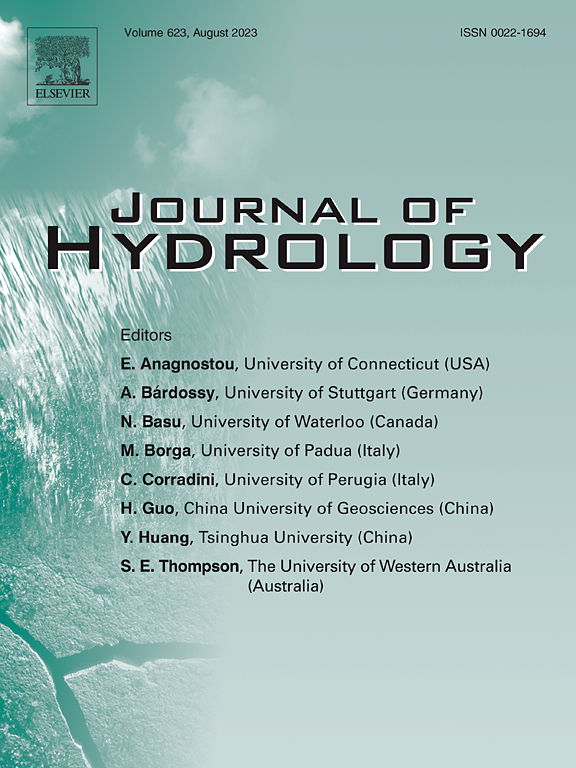A novel time-varying threshold level method for evaluating non-stationary hydrological drought
IF 6.3
1区 地球科学
Q1 ENGINEERING, CIVIL
引用次数: 0
Abstract
Affected by climate change and human activities, the evolution of drought has become more complex. Traditional drought assessment methods based on the assumption of stationarity are facing challenges. Currently, research on the non-stationary improvement of standardized drought indices (SDI) is relatively mature, while research on threshold level methods (TL) is still in its infancy. In this study, we propose a “deconstruct-reshape” framework to construct a time-varying threshold level (TLvar) method for assessing non-stationary hydrological droughts. Deconstruction refers to decomposing non-stationary streamflow series into periodic and trend terms. Then, the periodic terms are combined to generate a de-trend streamflow series to extract the threshold value. Reconstruction refers to the linear superposition of the extracted threshold and trend term to obtain the reconstructed TLvar. These two steps are the innovations of this study. Furthermore, the method was performed in 49 human-induced watersheds around the world. Kendall correlation analysis demonstrated that the correlation coefficients between the drought-flood series characterized by the TLvar method and the well-established time-varying parameter standardized streamflow index (SSIvar) were 0.642 to 0.858 on a 3-month cumulative scale and 0.736 to 0.965 on a 12-month cumulative scale. Meanwhile, a strong correlation has been identified between the drought-flood series characterized by SSIvar and TLvar and the Standardized Precipitation Index (SPI) series, particularly during periods of drought, in both small and large watersheds. In addition, the verification results based on historical drought events in the EM-DAT database demonstrated that the TLvar method can accurately capture historical drought events and reasonably assess their severity, avoiding the problems of underestimation or overestimation of drought events in traditional methods. Overall, the TLvar method proposed in this study is an effective method that can serve as an important complement to existing non-stationary drought assessment methods. This method could be applied with SSIvar to facilitate qualitative comparisons of drought severity and quantify streamflow deficit volumes in specific catchments, thereby achieving a comprehensive qualitative to quantitative assessment of non-stationary hydrological drought.
一种新的非平稳水文干旱时变阈值水平评价方法
受气候变化和人类活动的影响,干旱的演变变得更加复杂。传统的基于平稳性假设的干旱评价方法正面临挑战。目前,标准化干旱指数(SDI)的非平稳改进研究已经较为成熟,而阈值水平法(TL)的研究还处于起步阶段。在这项研究中,我们提出了一个“解构-重塑”框架来构建一个时变阈值水平(TLvar)方法来评估非平稳水文干旱。解构是指将非平稳流序列分解为周期项和趋势项。然后,将周期项组合生成反趋势流序列,提取阈值。重构是将提取的阈值与趋势项进行线性叠加,得到重构的TLvar。这两个步骤是本研究的创新之处。此外,该方法还在全球49个人为流域中进行了实验。Kendall相关分析表明,TLvar方法表征的旱涝序列与建立的时变参数标准化河流流量指数(SSIvar)在3个月累积尺度上的相关系数为0.642 ~ 0.858,在12个月累积尺度上的相关系数为0.736 ~ 0.965。同时,以SSIvar和TLvar为特征的旱涝序列与标准化降水指数(SPI)序列之间存在较强的相关性,特别是在干旱时期,在小流域和大流域都是如此。此外,基于EM-DAT数据库历史干旱事件的验证结果表明,TLvar方法能够准确捕获历史干旱事件并合理评估其严重程度,避免了传统方法对干旱事件的低估或高估问题。总的来说,本文提出的TLvar方法是一种有效的方法,可以作为现有非平稳干旱评估方法的重要补充。该方法可与SSIvar相结合,促进干旱严重程度的定性比较,量化特定流域的流量亏缺量,从而实现对非平稳水文干旱的综合定性到定量评估。
本文章由计算机程序翻译,如有差异,请以英文原文为准。
求助全文
约1分钟内获得全文
求助全文
来源期刊

Journal of Hydrology
地学-地球科学综合
CiteScore
11.00
自引率
12.50%
发文量
1309
审稿时长
7.5 months
期刊介绍:
The Journal of Hydrology publishes original research papers and comprehensive reviews in all the subfields of the hydrological sciences including water based management and policy issues that impact on economics and society. These comprise, but are not limited to the physical, chemical, biogeochemical, stochastic and systems aspects of surface and groundwater hydrology, hydrometeorology and hydrogeology. Relevant topics incorporating the insights and methodologies of disciplines such as climatology, water resource systems, hydraulics, agrohydrology, geomorphology, soil science, instrumentation and remote sensing, civil and environmental engineering are included. Social science perspectives on hydrological problems such as resource and ecological economics, environmental sociology, psychology and behavioural science, management and policy analysis are also invited. Multi-and interdisciplinary analyses of hydrological problems are within scope. The science published in the Journal of Hydrology is relevant to catchment scales rather than exclusively to a local scale or site.
 求助内容:
求助内容: 应助结果提醒方式:
应助结果提醒方式:


